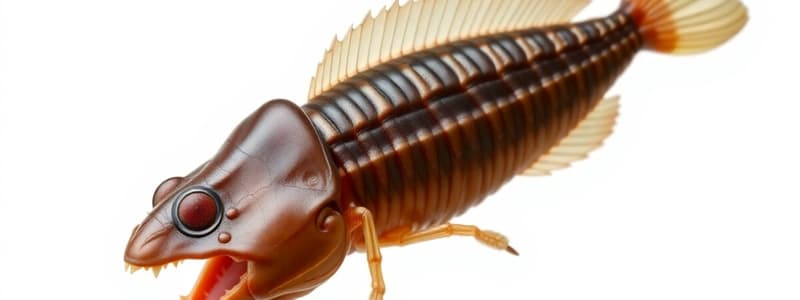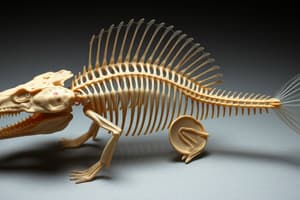Podcast
Questions and Answers
Osteichthyes are a class of fish that have skeletons reinforced by ______ phosphate.
Osteichthyes are a class of fish that have skeletons reinforced by ______ phosphate.
calcium
Unlike cartilaginous fishes, osteichthyes possess bony gill covers known as ______.
Unlike cartilaginous fishes, osteichthyes possess bony gill covers known as ______.
opercula
The class of fish known as ______ includes species with a bony skeleton.
The class of fish known as ______ includes species with a bony skeleton.
Osteichthyes
The vertebrate diversity presentation includes classes such as Chondrichthyes, Osteichthyes, and ______.
The vertebrate diversity presentation includes classes such as Chondrichthyes, Osteichthyes, and ______.
The festival grading criteria allocates ______% for the accuracy and quality of content.
The festival grading criteria allocates ______% for the accuracy and quality of content.
The ______ is a longitudinal, flexible rod located between the digestive tube and the nerve cord.
The ______ is a longitudinal, flexible rod located between the digestive tube and the nerve cord.
The dorsal, hollow ______ develops into the central nervous system.
The dorsal, hollow ______ develops into the central nervous system.
The ______ slits allow water entering the mouth to exit without going through the digestive tract.
The ______ slits allow water entering the mouth to exit without going through the digestive tract.
The ______ tail contains skeletal elements and muscles, providing propulsive force in aquatic species.
The ______ tail contains skeletal elements and muscles, providing propulsive force in aquatic species.
Some species, like Lancelets, belong to the subphylum ______.
Some species, like Lancelets, belong to the subphylum ______.
Urochordata, also known as ______, are sessile marine animals that attach to surfaces.
Urochordata, also known as ______, are sessile marine animals that attach to surfaces.
Hagfishes, which are jawless marine vertebrates, are categorized under the class ______.
Hagfishes, which are jawless marine vertebrates, are categorized under the class ______.
Some species of Urochordata are ______, while others are colonial.
Some species of Urochordata are ______, while others are colonial.
Lampreys are referred to as jawless vertebrates in the class ______.
Lampreys are referred to as jawless vertebrates in the class ______.
All chordates exhibit four common anatomical features: notochord, nerve cord, pharyngeal slits, and ______ tail.
All chordates exhibit four common anatomical features: notochord, nerve cord, pharyngeal slits, and ______ tail.
The class of fish that includes sharks and rays is known as ______.
The class of fish that includes sharks and rays is known as ______.
The structures of the chordate ______ provide insight into their evolutionary relationships.
The structures of the chordate ______ provide insight into their evolutionary relationships.
Bony fishes belong to the class ______, which is the most numerous vertebrate group.
Bony fishes belong to the class ______, which is the most numerous vertebrate group.
Lancelets live in the sand at the bottom of the sea in ______ areas.
Lancelets live in the sand at the bottom of the sea in ______ areas.
Hagfishes primarily function as ______ dwellers and scavengers.
Hagfishes primarily function as ______ dwellers and scavengers.
Bony fishes have skeletons reinforced by calcium ______.
Bony fishes have skeletons reinforced by calcium ______.
Flashcards
Osteichthyes
Osteichthyes
These are vertebrates with skeletons made of bone, unlike cartilaginous fish. They also have bony gill covers called opercula.
Vertebrates
Vertebrates
A group of animals with a backbone or spinal column, like humans and other mammals, fish, amphibians, reptiles, and birds.
Vertebrates
Vertebrates
A group of chordates that includes all the animals with backbones, including fish, amphibians, reptiles, birds, and mammals.
Kingdom
Kingdom
Signup and view all the flashcards
Chondrichthyes
Chondrichthyes
Signup and view all the flashcards
Notochord
Notochord
Signup and view all the flashcards
Nerve Cord
Nerve Cord
Signup and view all the flashcards
Pharyngeal Slits
Pharyngeal Slits
Signup and view all the flashcards
Post Anal Tail
Post Anal Tail
Signup and view all the flashcards
Chordates
Chordates
Signup and view all the flashcards
Urochordates
Urochordates
Signup and view all the flashcards
What are cephalochordates?
What are cephalochordates?
Signup and view all the flashcards
What defines hagfish?
What defines hagfish?
Signup and view all the flashcards
What is the lifestyle and defense mechanism of hagfish?
What is the lifestyle and defense mechanism of hagfish?
Signup and view all the flashcards
What characterizes lampreys?
What characterizes lampreys?
Signup and view all the flashcards
What is the defining feature of chondrichthyes?
What is the defining feature of chondrichthyes?
Signup and view all the flashcards
What are the defining features of bony fishes?
What are the defining features of bony fishes?
Signup and view all the flashcards
Describe cephalochordates.
Describe cephalochordates.
Signup and view all the flashcards
Describe Hagfish.
Describe Hagfish.
Signup and view all the flashcards
Study Notes
Phylum Chordata
- Chordates are animals characterized by four key features present at some stage of their development: notochord, dorsal hollow nerve cord, pharyngeal slits, and a post-anal tail.
- The notochord is a longitudinal, flexible rod located between the digestive tube and the nerve cord. It's made of large, fluid-filled cells encased in a stiff, fibrous tissue.
- The dorsal hollow nerve cord develops into the central nervous system (brain and spinal cord) in chordate embryos.
- Pharyngeal slits are openings in the pharynx that allow water entering the mouth to exit without passing through the entire digestive tract. They can also function as filter-feeding devices.
- The post-anal tail is a tail extending beyond the anus. It provides much of the propulsive force in many aquatic chordates and also contains skeletal elements and muscles.
Invertebrate Chordates
- Tunicates (Urochordata) are sessile marine animals that adhere to surfaces like rocks, docks, and boats. Other tunicates are planktonic.
- Lancelets (Cephalochordata) are blade-like animals a few centimeters long. They live in the sand at the bottom of coastal seas.
Vertebrates
- Vertebrates are chordates with backbones.
- Hagfishes (Myxini) are jawless marine vertebrates with cartilaginous skulls and axial skeletons derived from the notochord. They are bottom-dwelling scavengers. Slime glands secrete a sticky substance for protection.
- Lampreys (Petromyzontida) are jawless vertebrates with cartilage segments surrounding the notochord and arching partly over the nerve cord.
- Cartilaginous fishes (Chondrichthyes) include sharks and rays. They have cartilaginous skeletons that developed secondarily.
- Bony fishes (Osteichthyes) are the most numerous vertebrates. They have skeletons reinforced by calcium phosphate and opercula (bony gill covers).
Tetrapods
- Tetrapods are vertebrates with four limbs. Amphibians, reptiles, birds, and mammals are tetrapods.
Amphibians
- Amphibians have a three-chambered heart.
Reptiles
- Reptiles are amniotes and have a three-chambered heart. They lay amniotic eggs.
- Some reptiles, such as crocodiles, have a four-chambered heart.
Birds
- Birds are endotherms (warm-blooded) and have a four-chambered heart. They lay amniotic eggs.
Mammals
- Mammals are endotherms with a four-chambered heart. They possess mammary glands for nourishing young. They also have hair or fur.
- Diagrams and images depict the anatomical features of each group of chordates and vertebrates.
Studying That Suits You
Use AI to generate personalized quizzes and flashcards to suit your learning preferences.




